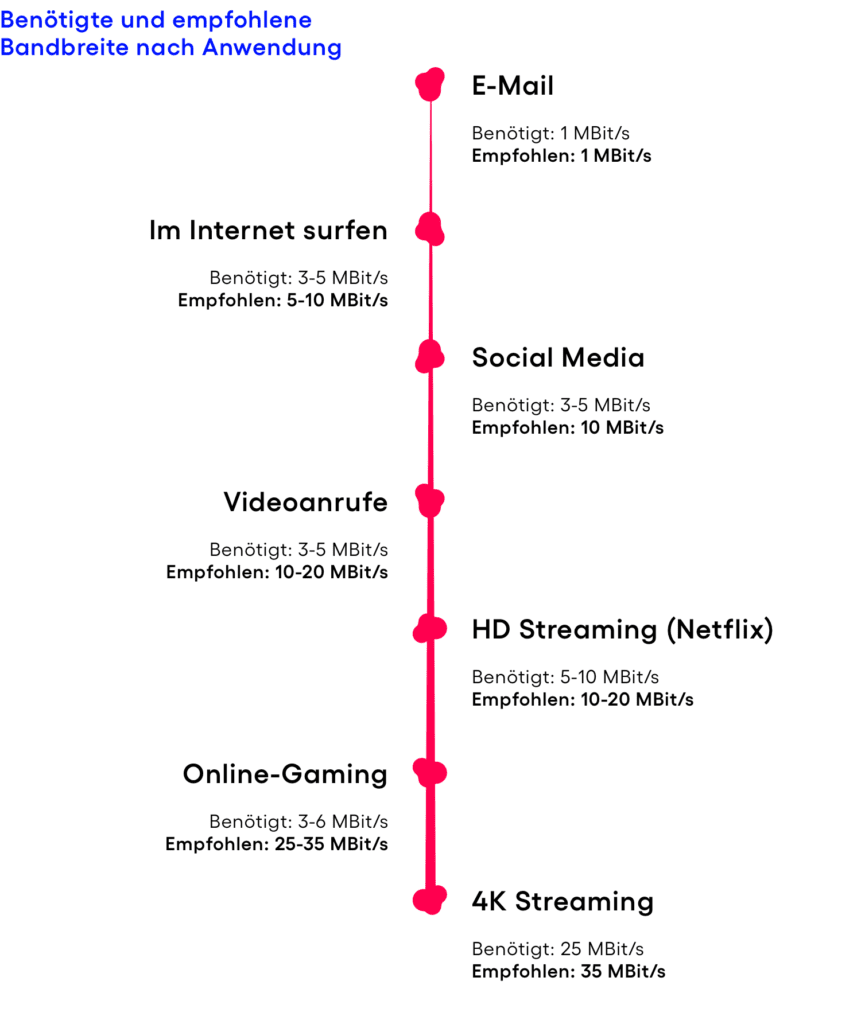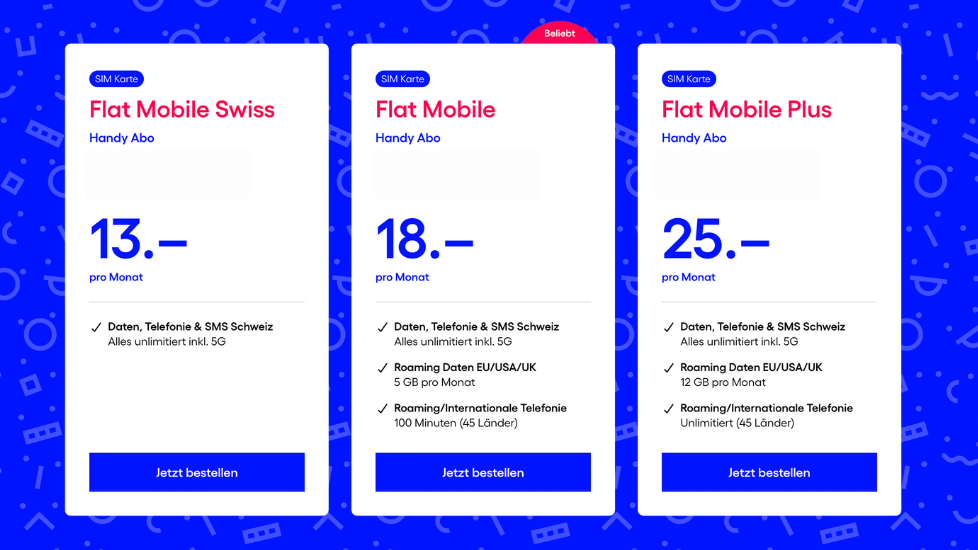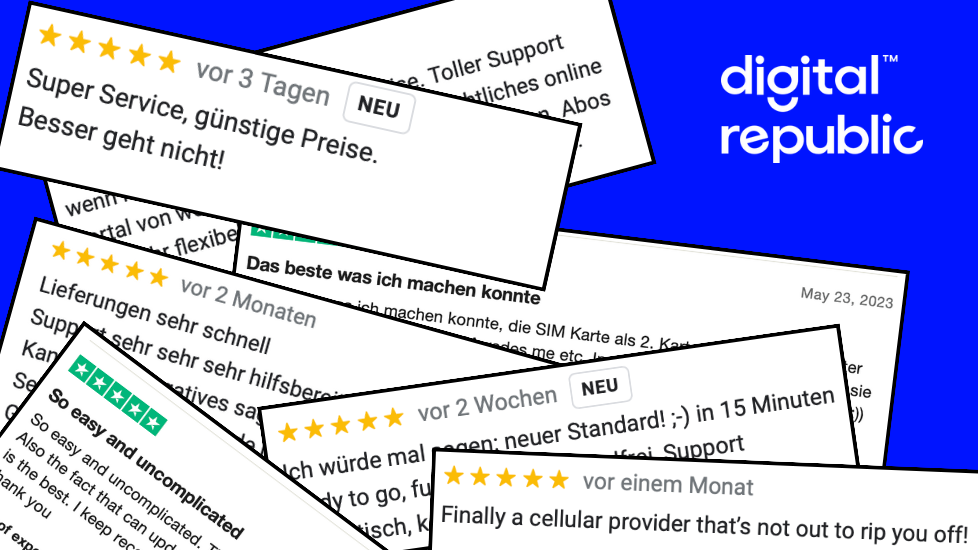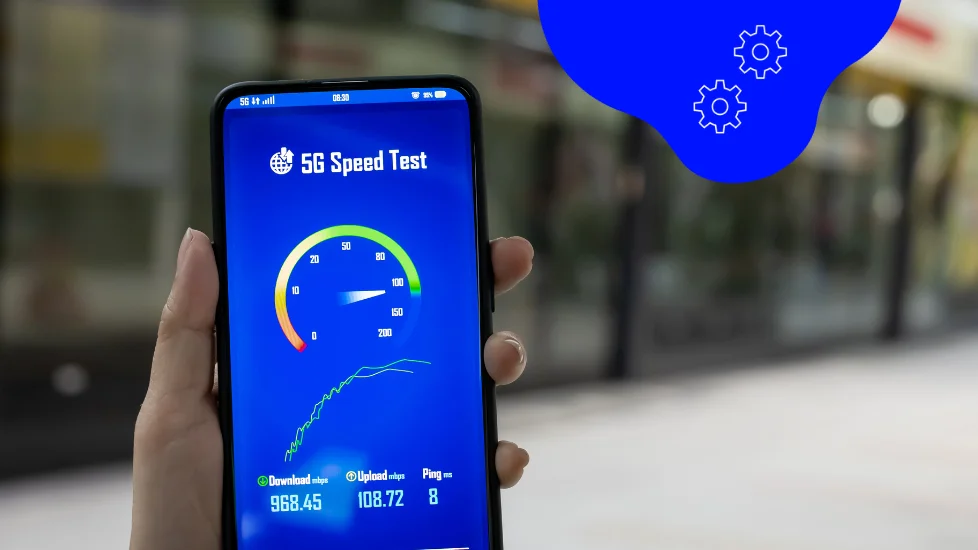Mobile internet for everyone and everything
This Is How Fast the Internet Needs to Be – Minimum Speed by Application
Updated on: October 13, 2025
What the Bandwidth Depends On
Who hasn’t been there? Your face freezes at the worst possible moment during a Zoom meeting, instead of confidently presenting the latest slide deck to your boss. Netflix just won’t load, and the hypnotic spinning of the loading symbol almost makes your eyes close. Slow internet is annoying! If you don’t want to make life difficult for yourself, choose a data plan with high internet speed. The market promises 100 Mbit/s, 300 Mbit/s, or even 1 Gbit/s. But what do these technical terms actually mean? And what internet speed do you really need to use everyday applications?
…The Basics First
If MBit/s, upload and download speed are foreign words to you, a brief explanation first: The internet speed – also known as bandwidth – defines how quickly a file is downloaded from the internet to your device (or vice versa). The bandwidth is measured in megabits per second (MBit/s) and indicates how many of the smallest digital storage units “bits” are transmitted per second. For example, if your internet speed is 50 MBit/s, you download 6.25 megabytes in one second. This corresponds approximately to the size of a standard MP3 song.
But why is the Internet speed always indicated with two numbers? This is the upload and download speed. Upload means how fast you send data to the Internet. Download, on the other hand, refers to how quickly you download data from the Internet. Upload is relevant for video calls or uploading photos, for example, while download is used when surfing the Internet. As a rule, you use more download bandwidth than upload bandwidth, which is reflected in the composition of most internet tariffs: 5 Mbit/s upload speed is often offset by 10 Mbit/s download speed.
Now you know what internet speed is, but you still don’t know how much of these Mbps you need. To choose the right data plan, you should answer the following two questions:
1. Which Internet Applications Do I Use?
First of all, you should consider which applications you usually use the internet for. Whether you are an avid gamer, influencer, Netflix addict or occasional surfer – the internet speed you need is always different and depends largely on your own usage behaviour. The following infographic gives you an overview of how many Mbps you need depending on your application.

As you can see, some applications don’t need as high a speed as you might think. You only need 1 Mbit/s to send and receive emails. Social media and surfing the internet also only require 3-5 MBit/s, depending on the website. To be able to hold smooth video calls with your team, we recommend 10-20 MBit/s. As soon as it comes to streaming videos, 5 Mbit/s is sufficient, but depending on the image resolution, it can get tight. With 10 MBit/s you can enjoy Netflix in FullHD without any problems. If you want to stream films on your 4K device in UltraHD, you are well served with 25-35 MBit/s.
2. What other factors influence the internet speed?
You have a line with a speed of 300 MBit/s and only achieve 50 MBit/s using a speed test? Unfortunately, this is normal. The figures refer to maximum speeds. A lightning-fast Internet subscription does not necessarily guarantee an effectively fast Internet connection and the speed at which you actually surf depends on a number of factors.
Hardware
If you have a Wi-Fi router that only has a throughput of 300 Mbit/s, even the best and fastest internet tariff with several Gbit/s won’t do you any good: the potential of your line cannot be utilised and you can only surf at a maximum of 300 Mbit/s. Older WLAN routers and wireless standards in particular are often slower than the faster line you paid for.
It is also important to note that nearby networks can interfere with your internet connection. Unfortunately, it is a fallacy that your personal Wi-Fi guarantees you exclusive, unrestricted surfing pleasure: the Wi-Fi signal is transmitted via two different frequency bands – the 2.4 and the 5 gigahertz frequency. These channels are also frequented by e.g. other routers in the same building and slow down your connection at peak times.
In addition, your device must be able to keep up with the potential of your internet connection. If your device is outdated or the software and operating system are not up to date, your internet speed may be affected.
Number of devices & persons
The advantages of a WLAN router are both a blessing and a curse. Numerous devices can be connected to the internet. While this is perfect for an all-round connected household, it also means a significant reduction in the speed you end up getting for each individual application. So when choosing your data plan, the number of people or devices using your internet connection is one of the most crucial factors. If you’re streaming and surfing as a single person, relatively few Mbps will suffice, while more will be required if there are several people.
Local factors
Free and central positioning of the router is essential for a smooth Internet connection. It should be in a place where the signal can be affected as little as possible. Hidden between the sofa, cupboard and chest of drawers, even the best router is powerless.
If you are not surfing via fiber optic or cable network, but via mobile Internet, obstacles between you and the nearest mobile phone antenna can also hinder the connection. The further away you are from the mobile phone antenna, the weaker the signal strength. If the signal has to overcome hills, buildings and finally the insulation of your home on the way to you, the speed will be further slowed down. If too many people rely on an internet connection at peak times, the mobile phone antenna may also be overloaded and the speed will suffer.
Although it is not possible to eliminate all disturbing factors, it can help to be aware of them in case the internet connection should go down.
Ready to Start Browsing?
Answering both questions will help you to choose the right speed. Imagine yourself in various situations in your everyday life and use the above graphics as a guide. This will help you identify the speed that best suits your needs.
As an existing or prospective DigitalRepublic customer, you can choose the right plan for you after analyzing your internet needs. Order a SIM card, measure how many Mbit/s you actually achieve within the first free month, and adjust the speed accordingly. You can upgrade or downgrade your subscription as you wish.
…And if that’s still not clear enough for you: our Flat 10 subscription is perfectly adequate for surfing the web, watching Netflix, and making video calls on your smartphone or tablet. If you also need phone calls and roaming, our Flat Mobile subscription could be just right for you.
Here you can find all mobile phone subscriptions from Digital Republic.
The Flat 50 or 300 plans are best suited if the connection is established at home using an LTE or 5G router and is used for numerous applications.
If you are still looking for a suitable router for your project, take a look at our LTE router test or the 5G router test. If you are looking for an affordable complete solution, 4G Home Start is available for just CHF 50!
Discover Our Other News Articles

The Development of Our Ideal Cell Phone Plans for Switzerland
The path to the current Trio Flat Mobile Swiss, Flat Mobile, and Flat Mobile Plus cell phone plans is also an example of how Digital Republic wants to function as a provider and where its priorities lie. We have quickly transformed ourselves from a pure data SIM provider to a cell phone plan provider. And we have completely rethought the development process.

The Affordable Mobile Provider With Award-Winning Service
When it comes to mobile providers in Switzerland, the wheat is often separated from the chaff when it comes to price. Either you pay little for your subscription and do without services like support or 5G, or you go to one of the big providers and pay more than you might like. At Digital Republic, you get both!

Why 5G Is Not Always Equally Fast
Sometimes fast, sometimes slow, sometimes suddenly 4G again. The network indicator on your smartphone suggests that it is connected to the internet via either 4G or 5G. In fact, a complex mechanism and a lot of communication between your smartphone and the network is taking place in the background to ensure that you always have the best possible connection.
